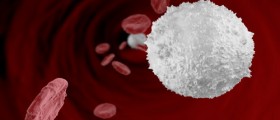
A low neutrophil count and a high lymphocyte count are both indicators of different diseases and disorders. It is important that people get to know what the neutrophils and lymphocytes are and which medical conditions are accompanied by changes in their count.
What are neutrophils and lymphocytes?
Neutrophils are the most abundant type of white blood cells in the human body. They are classified into two subtypes; segmented neutrophils or segs and banded neutrophils or bands. Segmented neutrophils are mature cells with a divided or segmented nucleus, while banded neutrophils are immature cells in which the nucleus has not yet become divided, making it appear like a band or a rod.
Neutrophil granulocytes play a crucial role in fighting against diseases and infections. These cells are a vital part of the immune system. Therefore, an excessively low level of neutrophils in the blood is usually one of the first signs of a medical problem.
Causes of a low neutrophil count
People with low numbers neutrophils are more vulnerable to infections and other diseases. An abnormally low neutrophil count is also known as neutropenia. Neutropenia can be caused by a decreased production of neutrophils or an increase in the destruction of neutrophils. A low neutrophil count can be a hereditary or acquired condition.
Decreased production of neutrophils may result from leukemia or aplastic anemia. Autoimmune diseases such as systemic lupus erythematosus can also lead to low neutrophil counts due to the destruction of these cells. Other diseases and disorders accompanied by low neutrophils are rheumatoid arthritis, hepatitis, myelofibrosis, malaria, mononucleosis, sepsis, enlargement of the spleen, Felty’s syndrome, histoplasmosis, rubeola, influenza, mumps, tuberculosis, and Kostmann’s syndrome.
A drop in someone's neutrophil count can also occur as a side effect of certain medications. These medications include chemotherapeutic medications, antibiotics, diuretics, lithium and phenothiazine drugs. A vitamin B12 or folic acid deficiency can also lead to low neutrophils. Furthermore, procedures like a bone marrow transplant, dialysis, and cardiopulmonary bypass can result in neutropenia.
What are lymphocytes?
Lymphocytes are another type of white blood cell, and the chief constituents of the immune system. Lymphocytes are produced by the bone marrow. There are three main types of lymphocytes. They are:
- B cells, which secrete antibodies
- T cells, which attack infected or malignant cells
- Natural Killer or NK cells, which destroy altered cells
What does a high lymphocytes count mean?
Whether there is low or high amount of lymphocytes in the body, an abnormality in their number always suggests the body is subject to an underlying disease process. Under normal circumstances, the white blood cells contain some 15 to 40% of lymphocytes. If there is an increase of lymphocytes over 40% of the total amount of white blood cells, this condition is known as a high lymphocyte count or lymphocytosis. A decreased amount of these white blood cells is also, on the other hand, problematic and this condition is called lymphocytopenia.
Most laboratories define the normal amount of lymphocytes in the blood to be about 1200 to 3200/ml (per milliliter). People should always consult their doctor to interpret any lab results, for he or she will be able to read them properly.
Different infections of the body may be the cause of lymphocytosis, especially chicken pox, rubella, mumps, toxoplasmosis and brucellosis (animal infections) or herpes simplex infection. Flu and whooping cough may also induce an increase in the amount of lymphocytes present in the blood.
Acute and chronic lymphocytic leukemias (ALL and CLL) are known to increase lymphocyte counts, as well. Mononucleosis, hepatitis or a cytomegalovirus infection of the stomach and eyes can also be blamed for an increased amount of these white blood cells.
The use of certain medications and blood transfusions might raise the level of lymphocytes in the blood as well.
Diseases such as ulcerative colitis or inflammatory bowel disease (IBS) or Crohn’s disease can be the reasons behind increased number of these blood cells. Some of the other reasons that may be responsible for the raise of lymphocytes are inflammation of blood cells, some autoimmune disorders and plasma cell cancer like multiple myeloma.
How to restore the balance
In humans, the lymph circulates through a well-organized and wide spread network of the lymph vessels. Lymph can be defined as interstitial fluid localized between the body cells. It is normally found inside the lymphatic system and once the damage of lymph vessels occurs the lymph accumulates in certain parts of the body and may form a cyst. This cyst is called lymphocele. So lymphocele represents a collection of lymph fluid in a sac, cavity or similar formation.
Lymphocele most commonly represents a complication of different surgical procedures. It particularly occurs if the surgery evolves manipulation in a very large area which is well supplied with lymphatic tissue. Any kind of the injury to this lymphatic tissue, to be more precise to lymphatic vessels may result in leakage of the lymph and formation of a lymphocele.
There are several more complications in a form of swelling and accumulation which are similar to lymphocele and they include hematoma, seroma, abscess and urinoma. After certain examinations and tests the doctor can set the definitive diagnosis.
Symptoms of lymphocele basically depend on the site of its formation and its size.
In case of renal transplantation surgery postoperative formation of lymphocele represents an emergency state. Renal transplant surgery is a serious procedure and if a lymphocele has formed it must not be left neglected. The very presence of lymphocele carries significant risk of organ rejection. Lymphocele can also interfere in normal functioning of the transplanted organ. So the symptoms are in this case connected to organ rejection and improper functioning of the transplanted kidney.
Lymphocele may also affect patients after a blunt trauma of the chest. The injury of the thoracic duct causes leakage of the lymph and formation of a lymphocele in the mediastinum. Apart from the symptoms related to trauma the lymphocele in this case can eventually cause breathing difficulties or be rather small and asymptomatic.
People should also know that lymphocele may also occur after pelvic and aortic lymphadenectomy.
Treatment for Lymphocele
The treatment for lymphocele depends on the severity of symptoms caused by the pressure of lymphocele. Lymphocele may withdraw spontaneously and in some cases the surgeon places a drain in order to eliminate the collected fluid. In more severe cases the patient undergoes surgical removal of the lymphocele.
















Your thoughts on this
Loading...